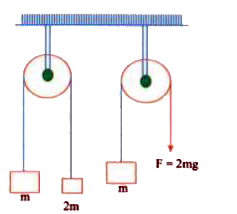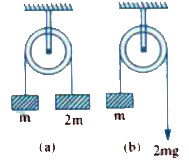The pulley arrangement of figure are identical. The mass of the rope is negligible. In (a) mass m is lifted up by attaching a mass (2m) to the other end of the rope. In (b), m is lifted up by pulling the other end of the rope with a constant downward force F = 2 mg. In which case, the acceleration of m is more?
 Solution in Tamil
Solution in Tamil
Case (a): a=(2m−m2m+m)g
Case (b): FBD of mass m
ma. = T-mg
ma. = 2mg - mg
⇒ ma. = mg
a. = g
So in case (b) acceleration of m is more.
Topper's Solved these Questions
- LAW OF MOTION Book:FULL MARKSChapter:LAW OF MOTION Exercise:ADDITIONAL QUESTIONS SOLVED (SHORT ANSWER QUESTIONS (2 MARKS))
Explore 12 Videos
- KINETIC THEORY OF GASESBook:FULL MARKSChapter:KINETIC THEORY OF GASESExercise:Addtional Numerical Problems
Explore 10 Videos
- MOTION OF SYSTEM OF PARTICLES AND RIGID BODIESBook:FULL MARKSChapter:MOTION OF SYSTEM OF PARTICLES AND RIGID BODIESExercise:ADDITIONAL QUESTIONS SOLVED - III (LONG ANSWER QUESTIONS (5 MARKS))
Explore 6 Videos
Similar Questions
A man getting down a runnning bus falls forward
View SolutionIf the rms speed of hydrogen molecules at 300K is1930ms−1. Then what is the rms speed of oxygen molecules at 1200K.
View SolutionDerive an expression for center of mass for distributed point masses.
View SolutionThe pulley arrangements of Figs. (a) and (b) are identical. The mass of the rope is negligible. In (a) the mass m is lifted up by attaching a mass 2m to the other end of the rope. In (b), m is lifted up by pulling the other end of the rope with a constant downward force F=2mg. The acceleration of m is the same in both cases

View SolutionThe pulley arrangement in Fig are identical .The mass of the rope is negligble in figure the mass m is lifted up by atteched a mass 2m to the other end of the rope . In (b), m is lifed up by pulley the other end of the rope with a constant in both cases
View SolutionFigure shown two pulley arrangments for lifting a mass m . In case-1, the mass is lifting by attaching a mass 2m while in case-2 the mass is lifted by pulling the other end with a downward force F=2mg . If aa and ab are the accelerations of the two masses then (Assumme string is massless and pulley is ideal).

View SolutionThe pulley arrangements shown in figure are identical, the mass of the rope being negligible. In case I the mass m is lifted by attaching a mass 2m to the other end of rope with a constant downward force F=2mg, where g is acceleration due to gravity The acceleration of mass m in case I is
 .
.
View SolutionThe pulley arrangements of fig (a) and (b) are identical. The mass of the rope is negligible. In (a) the mass m is lifted up by attaching a mass 2 m to the other end of the rope. In (b) m is lifted up by pulling the other end of the rope with a constant downward force F = 2 mg. Which of the following is correct?
View SolutionThe pulley arrangement of fig. are identical. The mass of the rope is negligible. In (a) mass m is lifted up by attaching a mass (2 m) to the other end of the rope. In (b), m is lifted up by pulling the other end of the rope with a constant downward force F =2 mg. In which case, the acceleration of m is more ?

View SolutionThe pulley arrangements shown in figure are identical, the mass of the rope being negligible. In case I, the mass m is lifted by attaching a mass 2m to the other end of rope with a constant downward force F = 2mg, where g is acceleration due to gravity. The acceleration of mass m in case I is

View SolutionThe pulley arrangements of figures (a) and (b) are identical. The mass of the rope is negligible. In figure (a), the mass m is lifted up by attaching a mass 2m to the other end of the rope. In figure(b), m is lifted up by pulling the other end of the rope with a constant downward force F = 2 mg. Calculate the accelerations in the two cases.

View SolutionThe pulley arrangements to Fig.(A) and (B), are identical. The mass of the rope is negligible. In (A) the mass mi s lifted up by attaching a mass 2m to the other end of the rope.
In (B) m is lifted up by pulling the other end of the rope with a constant downward force F=2mg. In which case the acceleration of 'm' is more?

View SolutionThe pulley arrangements of figures (a) and (b) are identical. The mass of the rope is negligible. In figure (a), the mass m is lifted up by attaching a mass 2m to the other end of the rope. In figure(b), m is lifted up by pulling the other end of the rope with a constant downward force F = 2 mg. Calculate the accelerations in the two cases.

View SolutionThe pulley arrangements to Fig.(A) and (B), are identical. The mass of the rope is negligible. In (A) the mass mi s lifted up by attaching a mass 2m to the other end of the rope. In (B) m is lifted up by pulling the other end of the rope with a constant downward force F=2mg. In which case the acceleration of 'm' is more?
View SolutionThe pulley arrangements of figures (I) and (II) are identical. The mass of the rope is negligible. In figure (I), the mass m is lifted up by attaching a mass 2m to the other end of the rope. In figure (II), m is lifted up by pulling the other end of the rope with a constant downward force F = 2 mg. Calculate the accelerations in the two cases.

View SolutionThe pulley arrangements of figures (a) and (b) are identical . The mass of the rope is negligible . In figure (a), the mass m is lifted up by attaching a mass 2m to the other end of the rope . In figure (b) , m is lifted up by pulling the other end of the rope with a constant downward force F=2mg . Calculate the accelerations in the two cases.
View Solution